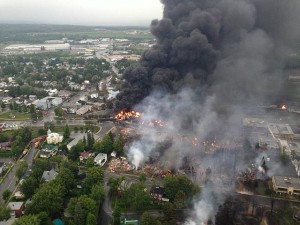Earlier this month, we ran a piece about the sharp increase in explosions, fires and other accidents involving trains carrying oil, and how we’ve seen more oil spilled in rail accidents in the last year than in the previous 35 years combined. This has led to the federal government requiring that railroads carrying more than 1 million gallons of highly flammable oil from the Bakken oil field in a single train – about 35 tank cars – disclose details of volatile oil shipments to the states.
This week, the Obama administration proposed new regulations on the safe transportation of flammable liquids. The proposal includes such things as better classification of mixed gases and liquids, rail routing risk assessments and disclosure of train details as mentioned above and reduced speeds. As far as improvements to the trains themselves go, the proposal includes better braking capabilities and sturdier tank cars.
Under the proposal, the DOT-111 tank car, which is the type most involved in spills, would be phased out or rebuilt to the new standards over a two year period. There’s three possible standards for the tank cars; the sturdiest of which would add $3 billion to transport costs over the next twenty years. However, it could also save $3.5 billion from avoided damage and death caused by accidents.
So, this all sounds good, right? Not really, if the truth were to be known. To begin with, the new regulations wouldn’t go into effect until October 1, 2015. Between now and then, all of the oil transported by rail will be in cars that have been deemed to be unsafe to transport Bakken crude oil. And, after that they’d have an additional two years to phase out or rebuild the cars.
Then, there’s the classification. The DOT release concerning the proposal states: “Specifically, within two years, it proposes the phase out of the use of older DOT-111 tank cars for the shipment of packing group I flammable liquids, including most Bakken crude oil, unless the tank cars are retrofitted to comply with new tank car design standards.”
Note that the proposal only calls for phasing out the DOT-111s for packing group I flammable liquids. Liquids classified as packing group II or III could still be shipped via DOT-111 cars. Tests of the oil from the Lac-Megantic disaster revealed that the oil should have been classified as packing group II. Under the new proposal, the Lac-Megantic train would be in compliance.
Matt Krogh of ForestEthics released a statement that sums it up quite nicely:
“Today the Obama administration announced weak new standards for high-hazard flammable trains that give the oil industry a license to threaten the safety of millions of Americans and leave communities and emergency responders holding the bag.
The administration seems to have carefully calculated and managed the inconvenience of these rules to the oil industry, but they’ve severely underestimated the threat of these trains to the American public.”
He also said that the administration needs to “go back to the drawing board and put public safety first.” We couldn’t agree more.
Occupy World Writes feels that the flaws in the proposed regulations are both obvious and dangerous. We encourage all to comment on the proposal when the 60 day public comment period starts; the proposal isn’t listed yet on regulations.gov.
Rolling bombs are not acceptable in our communities.


